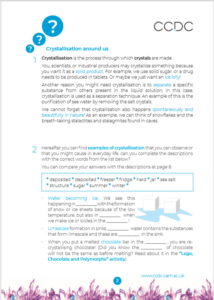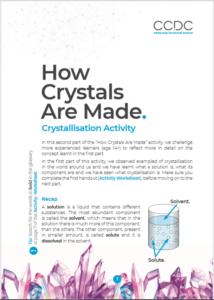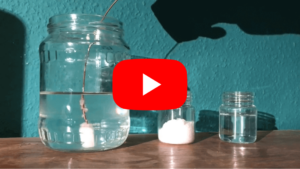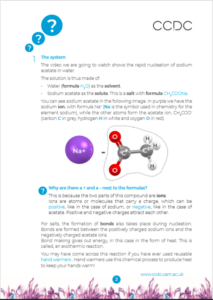How Crystals Are Made
This activity will introduce you to crystallisation, which is the process through which crystals are made.
Crystals, before being the solid product we can observe and touch, are very tiny crystal nuclei, which then grow! In this activity we will learn about the solution from which the nuclei are created and about crystallisation, using hands-on activities and a video of rapid nucleation, while discovering examples of crystallisation that are around us.
At the end of this activity, don’t forget to collect your reward! Please, ask an adult to download the collectable virtual badge.
What You Will Need:
This activity can be carried out online on a computer or you can download and print the activity worksheet. You will need scissors and optionally glue.
If printing is not possible, do not worry! The activities can be done drawing on a piece of paper (for which you will need paper and pencils) or in the form of a discussion.
You will need internet access to watch the video of crystallisation.
Learning Outcomes:
In this activity you will learn:
- Keywords about solution.
- What a supersaturated solution is.
- About crystallisation.
Recommended Age:
This activity is suitable for ages 8+ years with adult supervision and guidance.
Health & Safety:
These activities are carried out at your own risk.
Please read these health and safety guidelines to reduce risks.
- Any access to the internet for minors should be done under adult supervision.
- If you print and cut out the handouts and reward badge, please be aware of potential cuts from scissors or papers, and irritation from contact of glue with eyes, skin, hair or ingestion.
- If you intend to make a video related to this activity, please do so only under adult supervision.
Our Downloadable Educational Resources
In this section you can find the handouts to carry on the activity.
- The handout “Activity Worksheet” guides you and the learners step-by-step through the activity.
- The handout “Crystallisation Activity” contains additional activities for more advanced learners (age 14+).
Further Learning and Useful Links:
- Do you want to explore more crystallisation? Why not try our Crystals of Sugar activity from the Crystal Adventures. Watch the video and follow the instruction to create beautiful sugar crystals and observe crystallisation from solution in action!
- Classroom Teaching Modules: Crystallisation.
This module was developed for use in the classroom based on hands-on exercises used at the Cambridge Science Festival. Thanks to Louise Dawe (Wilfrid Laurier University) for assistance with curriculum benchmarking and Prof. Robert Pike at The College of William and Mary for providing additional resources.
- Some of the concepts and glossary used in this activity are discussed in other two CCDC Home Learning activities, i.e., Crystals Showcase and Lego, Chocolate and Polymorphs .
- To view the 3D structure of sodium acetate salts, you can choose structures from this list with refcode BOPKOG. You can refer to this page for tips and directions for viewing structures in the 3D Visualizer.
- To learn more about the elements that make the salt shown in the experiment video, you can explore the element pages for each of them from our Elements in Crystals project.
- To learn more about how to grow a crystal, you can visit the IUCr website.



